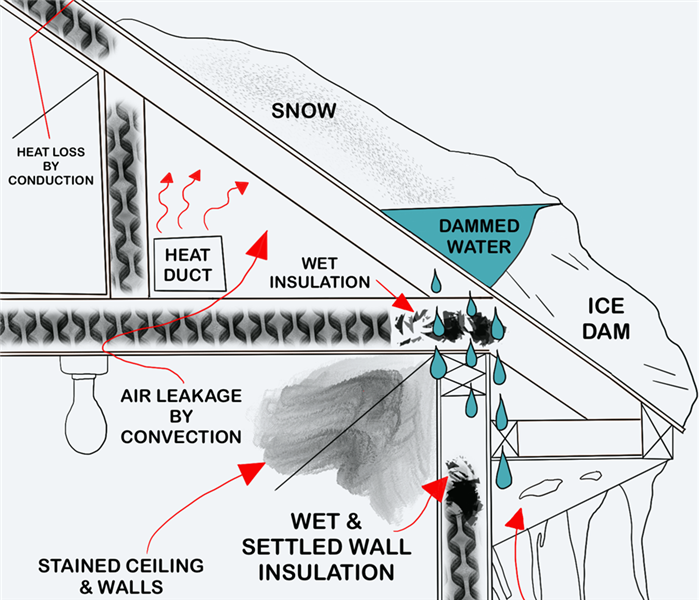Ice Dams, Are they Worth the Hype?
1/26/2022 (Permalink)
With such erratic temperatures in New England, especially living in the Northshore area of Massachusetts, Ice Dams can wreak havoc on your roof, eventually leading to interior damage! If your home should ever come under the damage to this type of ruin, SERVPRO of Beverly/Cape Ann is always here to help! Give us a call at (978) 927-8665.
What is an Ice Dam you say? An ice dam is a ridge of ice that forms at the edge of a roof and prevents melting snow (water) from draining off the roof. The water that backs up behind the dam can leak into a home and cause damage to walls, ceilings, insulation, and other areas. Moisture entering the home from ice dams can lead to the growth of mold and mildew. Nonuniform roof surface temperatures lead to ice dams.
Factors Leading to Ice Dams:
- Heat loss from a house, snow cover and outside temperatures interact to form ice dams.
- Freezing Temperatures (below 32° Fahrenheit) with snow on roof that is not cleared off.
- The snow on a roof surface that is above freezing will melt. As water flows down the roof it reaches the portion of the roof that is below 32F and freezes. This causes the ice dam.
- The dam grows as it is fed by the melting snow above it, but it will limit itself to the portions of the roof that average below 32F. So, the water above backs up behind the ice dam and remains a liquid.
This water finds cracks and openings in the exterior roof covering and flows into the attic space. From the attic it could flow into exterior walls or through the ceiling insulation and stain the ceiling finish. SERVPRO of Beverly/Cape Ann knows how to trap and extract the water left behind and mold from previous ice dams that were previously unseen and not delt with. How do nonuniform temperatures on the roof surface help create these pockets of water?
Heat from the House:
Heat from the house travels to the roof surface in three ways: conduction, convection, and radiation.
- Conduction is heat energy traveling through a solid. A good example of this is the heating of a cast iron frying pan. The heat moves from the bottom of the pan to the handle by conduction.
- If you put your hand above the frying pan, heat will reach it by the other two methods. The air right above the frying pan is heated and rises. The rising air carries heat/energy to your hand. This is heat transfer by convection.
- Heat also transfers from the hot pan to your hand by electromagnetic waves and this is called radiation. Another example of radiation is to stand outside on a bright sunny day and feel the heat from the sun. This heat transfers from the sun to you by
Convection and radiation heat transfer can be reduced by adding insulation. This will make the top surface temperature of the insulation closer to surrounding attic temperatures directly affecting convection and radiation from this surface.
Other Sources of Heat Loss:
- Heat Loss from Leakage
- Exhaust Systems
- Chimneys
All these different ways that lead to nonuniform temperatures should always be checked out by the professionals. Anyone on the roof during the winter or performing work on the roof from below risks injury and may cause damage to the roof and house. Whenever a house is tightened up, ventilation systems, exhausting devices and combustion devices must have enough air to operate safely and effectively. But when these factors go unseen always know that SERVPRO of Beverly/Cape Ann has your back with the clean up and restoration of your home during the coldest of months. Call us Today at (978) 927-8665





 24/7 Emergency Service
24/7 Emergency Service
